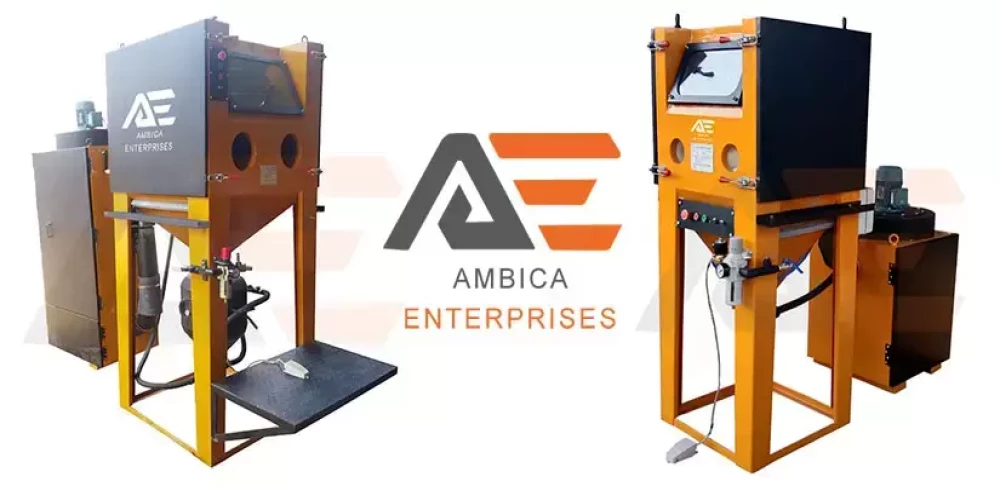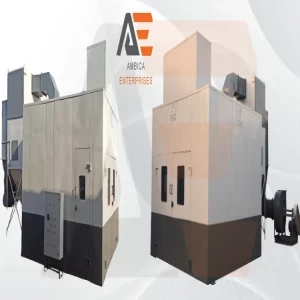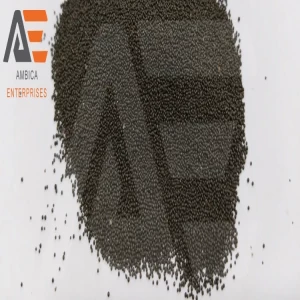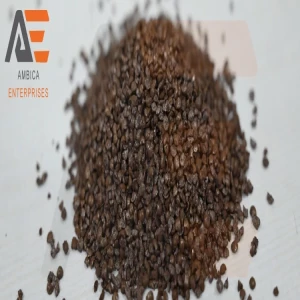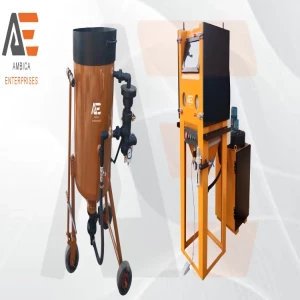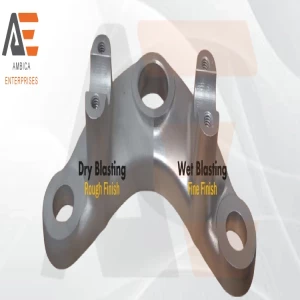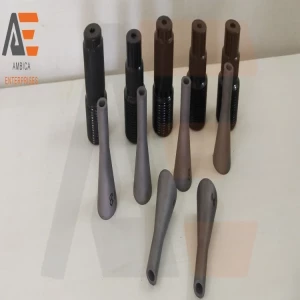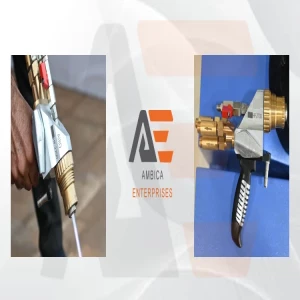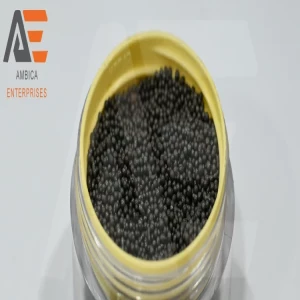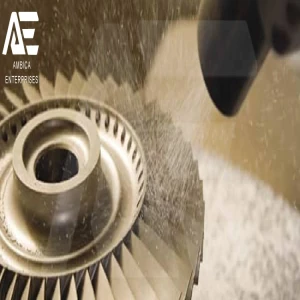A Pressure Blasting Cabinet is a unique enclosed space designed for carrying out abrasive blasting tasks. It offers a controlled setting where abrasive materials are forcefully propelled onto surfaces at high speeds. The purpose of this process is to prepare, clean, or finish surfaces through impact and abrasion using abrasive media like steel shots. The cabinet itself is constructed from sturdy materials like steel or fiberglass to ensure durability. It features several key components, including a viewing window that allows operators to monitor the blasting process, blast nozzles through which the abrasive media is expelled, gloves that enable operators to manipulate objects within the cabinet, and a dust collector system that captures airborne particles generated during the blasting process. The pressure blasting cabinet serves as a contained environment, protecting operators from exposure to the abrasive media and the associated debris. It also helps to contain the noise generated during the blasting process.
Components of a Pressure Blasting Cabinet
- Blasting Cabinet: The Blasting Cabinet is where abrasive cleaning happens. It has walls to keep abrasive materials inside and stop debris from going outside.
- Abrasive Media Storage Hopper: The Abrasive Media Storage Hopper holds abrasive materials like steel shots, grits, or glass beads. It makes sure there is enough abrasive for blasting.
- Pneumatic Controls: Pneumatic Controls adjust the air pressure and abrasive flow. They have valves, regulators, and gauges to change blasting settings.
- Blast Nozzles: Blast Nozzles spray abrasive materials onto surfaces being cleaned. They can aim at different angles and patterns.
- Dust Collector: The Dust Collector has filters to catch dust and debris, and uses abrasive in the air. It keeps the work area clean and safe.
Working Principle
Pressure blasting cabinets use compressed air. This force pushes abrasive materials from a storage area through nozzles onto a surface. The abrasive particles hit the surface. They remove dirt, rust, or old coatings from the surface. The particles also create a desired rough surface. The cabinet is enclosed to prevent dust and debris from escaping. A dust collector captures and filters airborne particles through a pleated filter bag. These particles can then be disposed of or reused.
How does a Sand Blasting Cabinet work?
A pressure blasting cabinet works by speeding up small particles and propelling them at a surface. This is how it works step-by-step:
Step 1: Abrasive Media Selection
First, workers choose the right abrasive media for the job. They pick abrasive media based on the surface material, the desired finish, and how much blasting is needed. Common particle choices include steel shots, grits, glass beads, aluminum oxide, and garnet.
Step 2: Equipment Setup
Next, workers set up the blasting cabinet before starting. They load the chosen particles into the storage area. They adjust the air pressure and particle flow controls. They also check that the venting and dust collection systems are working right.
Step 3: Surface Preparation
The area needs cleaning. Workers remove dirt and grease and check for issues. Some parts may have covers to protect them from the blasting.
Step 4: Blasting Operation
Workers put on safety Wear like gloves, goggles, masks, and a sand blasting helmet. Powerful air or machines shoot tiny particles at high speeds onto the surface. This removes rust, old paint, and other unwanted things.
Step 5: Monitoring and Adjustments
While blasting, workers watch the air pressure, particle flow, and the distance from the nozzle. They may adjust these to get the best results and quality.
Step 6: Quality Control
After blasting, workers look closely at the surface. They check if it meets requirements for roughness, cleanliness, and if new coatings will stick properly. Special tests like surface profilometry may also happen.
Step 7: Cleanup and Maintenance
When the blasting process ends, all used materials, dust, and leftover bits are taken out of the cabinet. This is done with a system that collects dust. After that, the cabinet and equipment are cleaned, oiled, and checked for any damage or worn-out parts. This ensures that everything will keep working properly.
Step 8: Safety Measures
During the entire blasting process, the workers follow all safety rules. They do this to stop accidents, injuries, or harm to the environment from happening. They wear the right protective clothing, gear, and safety wear. They also take steps to control dust. And they do proper maintenance checks.
What are the components of a Pressure Blasting Cabinet?
Pressure blasting cabinets help clean surfaces using abrasive materials. These cabinets have several important parts that work together:
- Blasting Cabinet: The blasting cabinet is the main area where abrasive cleaning happens. It is made of strong materials like steel or fiberglass. The enclosed space keeps dust and debris inside.
- Abrasive Media Storage Hopper: The sand blasting hopper holds abrasive materials like steel shots, grits, or beads. It provides a steady supply during cleaning. This allows the surface treatment to continue without stopping.
- Pneumatic Controls: Air and abrasive materials move through the cabinet by pneumatic controls. These controls include valves, regulators, gauges, and panels. They lets you change the air pressure, abrasive flow, and nozzle angle.
- Blast Nozzles: Blast nozzles or guns expel abrasive media onto surfaces. They come in different sizes, shapes, and materials for various applications. Nozzles adjust for diverse angles and spray patterns. This achieves the desired surface coverage and finish.
- Dust Collector: A dust collector is an essential part of a pressure blasting cabinet. It captures and filters airborne dust and spent abrasive media. The collector has a ventilation system with filters, cyclones, or separators. This ensures a clean and safe work area.
- Viewing Window: The viewing window lets people see the blast room. It allows them to watch blasting and check the surface being cleaned. The window is made of strong materials like tempered glass or plastic that can handle abrasive impact.
- Gloves and Access Ports: Gloves and openings let people reach into the blasting room while keeping it sealed. They wear tough rubber or plastic gloves to protect from abrasive impact and dust.
- Lighting: Lights inside the blasting room help people see while blasting and checking surfaces. LED lights are often used because they save energy and last a long time in tough conditions.
- Control Panel: The control panel houses pneumatic controls, electrical switches, and indicators for operating the pressure blasting cabinet. Operators use the control panel to adjust blasting parameters, monitor equipment status, and troubleshoot issues during operation.
- Workpiece Support: Workpiece support fixtures or racks hold the workpieces in place within the sand blasting cabinet during blasting operations. They ensure proper positioning and stability of the workpieces for uniform surface treatment.
What are the advantages of using a Pressure Blasting Cabinet?
Sand blasting cabinets are better than open blasting methods. Here are some important benefits of using a pressure blasting cabinet for surface preparation and finishing:
- Improved Control and Precision: Pressure blasting cabinets give operators more control over blasting. They can adjust air pressure, how much abrasive comes out, and the angle of the sand blasting nozzle. This allows them to target the surface precisely with the abrasive, resulting in a uniform finish.
- Reduced Abrasive Consumption: Pressure blasting cabinets reuse the abrasive media in a closed system. This means less abrasive is wasted. Operators don't need to replace the abrasive as often or dispose of it as much. This saves money over time.
- Enhanced Operator Safety: The enclosed design of pressure blasting cabinets protects operators from exposure to airborne dust, debris, and rebounding particles. Operators wear protective gear such as gloves, goggles, and respirators to minimize the risk of injury during blasting operations.
- Dust Containment: Pressure blasting cabinets feature fabric bag dust collector systems that capture and filter airborne dust, debris, and spent abrasive media. This ensures a clean and safe working environment, reduces the risk of respiratory hazards, and promotes compliance with occupational health and safety regulations.
- Versatility: Pressure blasting cabinets can accommodate a wide range of abrasive media, allowing for versatility in surface treatment applications. Operators can choose the appropriate abrasive media based on the material composition of the surface, the desired finish, and the intensity of blasting required.
- Environmental Sustainability: By minimizing abrasive wastage and containing dust and debris within the enclosed workspace, pressure blasting cabinets promote environmental sustainability. Recycling abrasive media and implementing eco-friendly practices reduce the ecological footprint and support sustainable blasting operations.
- Consistent Finish: The controlled environment of a shot blasting cabinet ensures consistent and uniform surface treatment across workpieces. This results in a high-quality finish with minimal variation, enhancing the aesthetics and functionality of treated surfaces.
- Productivity: Pressure blasting cabinets offer high throughput and productivity compared to traditional open blasting methods. Operators can achieve faster cycle times and process larger volumes of workpieces, leading to increased efficiency and production capacity.
- Surface Preparation: Pressure blasting cabinets effectively remove contaminants, rust, scale, or old coatings from surfaces, preparing them for subsequent finishing processes such as painting, coating, or bonding. This ensures optimal adhesion and durability of applied coatings, enhancing product quality and longevity.
- Customization: Pressure blasting cabinets can be customized to suit specific application requirements and workpiece sizes. Optional features such as an automatic sand blasting machine, turntables, oscillating guns, or robotic automation enhance flexibility and adaptability for diverse blasting operations.
How do you set up a Sand Blasting Cabinet?
Setting up a pressure blasting cabinet involves several steps to ensure proper installation, calibration of equipment, and adherence to safety precautions. Here's a detailed guide on how to set up a pressure blasting cabinet for optimal performance:
- Location and Environment: Choose a suitable location for installing the pressure blasting cabinet and air compressor, considering factors such as ventilation, access to utilities, and proximity to other equipment or workstations. Ensure adequate clearance around the cabinet for ventilation and maintenance.
- Installation: Follow the manufacturer's instructions for assembling and installing the sand blasting cabinet. Secure the cabinet to a stable and level surface using anchors or mounting brackets to prevent vibration or movement during operation.
- Electrical Connections: Connect the pressure blasting cabinet to a reliable power source using appropriate electrical cables and connectors. Ensure that the electrical supply meets the voltage and amperage requirements specified by the manufacturer.
- Abrasive Media Setup: Fill the abrasive media storage hopper with the chosen abrasive media, such as steel shots, steel grits, or beads. Ensure that the abrasive media is clean, dry, and free from contamination to prevent clogging or abrasive impingement issues.
- Pneumatic Controls: Calibrate pneumatic controls such as pressure regulators, valves, and gauges to achieve the desired blasting parameters. Adjust air pressure, abrasive flow rate, and nozzle angle according to the material composition of the surface and the desired finish.
- Ventilation and Dust Control: Ensure proper ventilation and dust control measures are in place to minimize airborne dust, debris, and abrasive media exposure. Install a dust collector or exhaust system to capture and filter dust generated during blasting operations.
- Safety Precautions: Implement safety precautions such as wearing appropriate personal protective equipment (PPE), including gloves, goggles, and respirators, to protect against dust, debris, and abrasive impact. Train operators on safe operating procedures and emergency protocols.
- Testing and Calibration: Perform a trial run of the pressure blasting cabinet to test equipment functionality and blasting performance. Monitor blasting parameters, surface quality, and dust levels to ensure proper operation and compliance with safety standards.
- Maintenance Schedule: Establish a regular maintenance schedule for the pressure blasting cabinet and suction blasting cabinet to ensure continued performance and longevity of equipment. Schedule routine inspections, cleaning, lubrication, and replacement of worn or damaged components as needed.
- Operator Training: Provide comprehensive training to operators on the pressure blasting cabinet's operation, maintenance, and safety protocols. Ensure operators are familiar with equipment controls, troubleshooting procedures, and emergency shutdown protocols to prevent accidents or injuries.
Following these steps, you can effectively set up a pressure blasting cabinet for optimal performance, safety, and productivity in surface treatment operations.
What types of abrasive media can be used in a Pressure Blasting Cabinet?
Pressure blasting cabinets are compatible with a wide range of abrasive media, each offering unique properties and applications. Here are some commonly used abrasive media in pressure blasting cabinets:
- Steel Shots: Steel shots are spherical metallic particles made from carbon steel or stainless steel. They are highly durable and impact-resistant, making them ideal for removing rust, scale, and surface contaminants from metal surfaces.
- Grits: Grits are angular abrasive particles made from materials such as aluminum oxide, silicon carbide, or garnet. They are available in various grit sizes and hardness levels, making them suitable for aggressive surface profiling and cleaning applications.
- Glass Beads: Glass beads are spherical abrasive particles made from recycled glass. They are non-abrasive and environmentally friendly, making them ideal for cleaning, deburring, and peening delicate surfaces such as aluminum, plastic, or composite materials.
- Aluminum Oxide: Virgin aluminum oxide is a sharp and durable abrasive material commonly used for surface cleaning, deburring, and finishing applications. It is available in different grit sizes and is suitable for both ferrous and non-ferrous materials.
- Garnet: Garnet is a natural mineral abrasive known for its high hardness and sharpness. It is commonly used for surface preparation, cleaning, and profiling of metal, wood, and stone surfaces in pressure blasting cabinets.
- Silicon Carbide: Silicon carbide is a hard and brittle abrasive material with excellent cutting and grinding properties. It is used for aggressive material removal and surface finishing applications, particularly on hard and brittle materials such as ceramics or carbides.
- Plastic Media: Plastic media made from materials such as urea, acrylic, or polyester is used for gentle surface cleaning, deflashing, and paint stripping applications. It is non-abrasive and suitable for sensitive materials such as plastics, composites, or delicate substrates.
- Walnut Shells: Walnut shells are biodegradable abrasive particles made from crushed walnut shells. They are soft and non-abrasive, making them ideal for cleaning, polishing, and deflashing applications on delicate surfaces such as wood, plastic, or fiberglass.
By selecting the appropriate abrasive media based on the material composition of the surface, the desired finish, and the intensity of blasting required, operators can achieve optimal results in pressure blasting operations.
What are the safety measures for operating a Pressure Blasting Cabinet?
Safety is paramount when operating a pressure blasting cabinet to prevent accidents, injuries, or equipment damage. Here are some essential safety measures to follow:
- Personal Protective Equipment (PPE): Operators must wear appropriate PPE such as gloves, safety goggles, face shields, and respirators to protect against abrasive impact, dust exposure, and airborne contaminants.
- Dust Control: Implement dust control measures such as dust collectors, exhaust systems, or containment enclosures to minimize airborne dust and maintain air quality in the workspace.
- Ventilation: Ensure proper ventilation in the blasting area to prevent the buildup of airborne dust, fumes, or gases. Ventilation systems should provide adequate airflow and fresh air exchange to maintain a safe working environment.
- Equipment Inspection: Regularly inspect pressure blasting cabinets, a blasting hose, nozzles, and pneumatic controls for signs of wear, damage, or deterioration. Replace worn or damaged components promptly to prevent equipment malfunction or accidents.
- Operator Training: Provide comprehensive training to operators on the safe operation of pressure blasting cabinets, including equipment controls, emergency shutdown procedures, and PPE usage. Ensure operators are aware of potential hazards and how to mitigate risks during blasting operations.
- Housekeeping: Maintain a clean and organized workspace by removing debris, spent abrasive media, and other hazards from the blasting area. Proper housekeeping reduces the risk of slips, trips, and falls, and ensures a safe working environment for operators.
- Emergency Preparedness: Establish emergency protocols and procedures for responding to accidents, injuries, or equipment malfunctions during blasting operations. Provide access to first aid kits, emergency eyewash stations, and fire extinguishers for immediate response.
By implementing these safety measures and protocols, operators can minimize the risk of accidents and injuries when operating pressure blasting cabinets, ensuring a safe and productive working environment.
What industries commonly utilize Pressure Blasting Cabinets?
Pressure blasting cabinets find widespread applications across various industries for surface preparation, cleaning, and finishing of diverse materials and components. Here are some industries that commonly utilize pressure blasting cabinets:
- Automotive Industry: Pressure blasting cabinets are used for cleaning and prepping car parts such as chassis, body panels, wheels, and engine components. They remove paint, rust, scale, and surface contaminants, preparing surfaces for painting, powder coating, or plating.
- Aerospace Industry: Pressure blasting cabinets are employed in the aerospace industry for surface finishing of aircraft components such as landing gear, turbine blades, engine casings, and structural elements. They clean, deburr, and texture surfaces to ensure optimal performance, durability, and safety.
- Manufacturing Sector: Manufacturing facilities utilize pressure blasting cabinets for cleaning, deburring, and surface finishing of metal, plastic, and composite parts. They remove burrs, sharp edges, and surface imperfections, enhancing product quality and functionality.
- Construction Sector: Pressure blasting cabinets are used in the construction sector for refurbishing bridges, highways, pipelines, tanks, and other steel structures. They remove rust, corrosion, and old coatings, extending the service life and enhancing the structural integrity of steel components.
- Marine Industry: In the marine industry, pressure blasting cabinets are used for cleaning and surface preparation of ship hulls, decks, and marine equipment. They remove marine fouling, corrosion, and old coatings, maintaining vessel performance and longevity.
- Metal Fabrication: Metal fabrication shops utilize pressure blasting cabinets for surface preparation and finishing of fabricated metal parts such as weldments, castings, and forgings. They remove scale, weld spatter, and surface contaminants, ensuring weld quality and paint adhesion.
- Restoration and Preservation: Pressure blasting cabinets are employed in restoration and preservation projects for cleaning and refurbishing historical artifacts, monuments, and architectural structures. They remove dirt, grime, and surface deterioration, restoring the original appearance and integrity of cultural heritage sites.
- Electronics Manufacturing: In electronics manufacturing, pressure blasting cabinets are used for precision cleaning and surface treatment of circuit boards, semiconductor components, and electronic assemblies. They remove flux residues, solder paste, and contaminants, ensuring the reliability and performance of electronic devices.
- Woodworking and Furniture: Woodworking shops and furniture manufacturers utilize pressure blasting cabinets for surface preparation and finishing of wooden components. They remove paint, varnish, and surface imperfections, revealing the natural beauty of wood grain and enhancing stain adhesion.
- Medical Device Manufacturing: In the medical device industry, pressure blasting cabinets are used for cleaning and surface treatment of surgical instruments, implants, and medical equipment. They remove biofilms, contaminants, and oxidation, ensuring sterility and biocompatibility of medical devices.
By catering to diverse industrial applications, pressure blasting cabinets play a crucial role in achieving high-quality surface finishes, product performance, and operational efficiency across various sectors.
How do you maintain a pressure blasting cabinet?
Regular maintenance and care are essential to ensure the longevity and performance of pressure blasting cabinets. Here are some maintenance tips to keep your equipment in optimal condition:
- Cleaning and Lubrication: Regularly clean and lubricate moving parts such as blast nozzles, hoses, valves, and pneumatic controls to prevent corrosion, binding, or wear. Use compatible lubricants and solvents recommended by the manufacturer.
- Inspections and Repairs: Periodically inspect pressure blasting cabinets for signs of wear, damage, or deterioration. Check for leaks, cracks, or loose fittings in hoses, nozzles, and pneumatic controls, and repair or replace damaged components as needed.
- Filter Replacement: Replace filters in the dust collector or ventilation system as recommended by the manufacturer to maintain proper airflow and dust collection efficiency. Clean or replace filters regularly to prevent clogging and ensure optimal dust containment.
- Abrasive Media Management: Monitor abrasive media levels in the storage hopper and replenish as needed to maintain consistent blasting performance. Remove debris, fines, or contaminants from the abrasive media to prevent nozzle clogging and ensure uniform surface treatment.
- Electrical Maintenance: Inspect electrical connections, switches, and controls for signs of wear, damage, or overheating. Tighten loose connections, replace worn components, and test electrical systems periodically to ensure safe and reliable operation.
- Operator Training: Provide comprehensive training to operators on proper equipment operation, maintenance procedures, and safety protocols. Educate operators on the importance of regular maintenance and preventive care to prolong the life of pressure blasting cabinets.
- Calibration and Testing: Calibrate pneumatic controls, pressure gauges, and blast nozzles periodically to ensure accurate blasting parameters and consistent performance. Conduct performance tests and quality checks to verify equipment functionality and surface finish quality.
- Documentation and Records: Maintain detailed records of maintenance activities, inspections, repairs, and equipment upgrades. Keep track of spare parts inventory, service schedules, and warranty information to facilitate timely maintenance and troubleshooting.
By following these maintenance practices and incorporating a proactive approach to equipment care, operators can ensure the reliability, performance, and longevity of pressure blasting cabinets in their operations.
What are the environmental considerations associated with Pressure Blasting Cabinets?
Pressure blasting cabinets play a crucial role in surface preparation and finishing operations across various industries. However, they also pose environmental considerations related to abrasive waste management, air and noise pollution, and regulatory compliance. Here's an overview of environmental considerations associated with pressure blasting cabinets:
- Abrasive Waste Management: Pressure blasting cabinets generate spent abrasive media, dust, and debris during blasting operations. Proper management of abrasive waste is essential to minimize environmental impact and ensure compliance with waste disposal regulations.
- Recycling and Reuse: Where feasible, recycle and reuse spent abrasive media to reduce waste generation and conserve natural resources. Implement abrasive media recycling systems or closed-loop blasting processes to reclaim and clean used abrasive for reuse in subsequent blasting operations.
- Dust and Air Pollution: Pressure blasting cabinets produce airborne dust, particulates, and fumes that can pose respiratory hazards and contribute to air pollution. Install dust collection systems, exhaust ventilation, or containment enclosures to capture and control airborne emissions, ensuring a safe and clean working environment.
- Noise Pollution: Blasting operations generate noise levels that may exceed occupational health and safety limits, posing risks to workers and nearby communities. Implement noise control measures such as soundproofing enclosures, acoustic barriers, or hearing protection to mitigate noise pollution and protect hearing health.
- Regulatory Compliance: Comply with environmental regulations governing air quality, waste management, and occupational health and safety standards. Stay informed about regulatory requirements applicable to pressure blasting operations and implement best practices to ensure compliance and prevent environmental violations.
- Energy Efficiency: Promote energy efficiency in pressure blasting operations by optimizing equipment design, implementing energy-saving technologies, and minimizing energy consumption. Use variable speed drives, energy-efficient motors, and automated controls to reduce power usage and operational costs.
- Sustainability Practices: Adopt sustainable practices such as eco-friendly abrasive media, water-based cleaning solutions, and renewable energy sources to minimize environmental impact. Incorporate green initiatives into blasting operations to reduce carbon footprint and promote environmental stewardship.
By addressing environmental considerations and implementing sustainable practices, pressure blasting cabinet operators can minimize their ecological footprint, reduce environmental impact, and contribute to a cleaner and healthier planet.

